ROCCAT Kave XTD 5.1 Analog
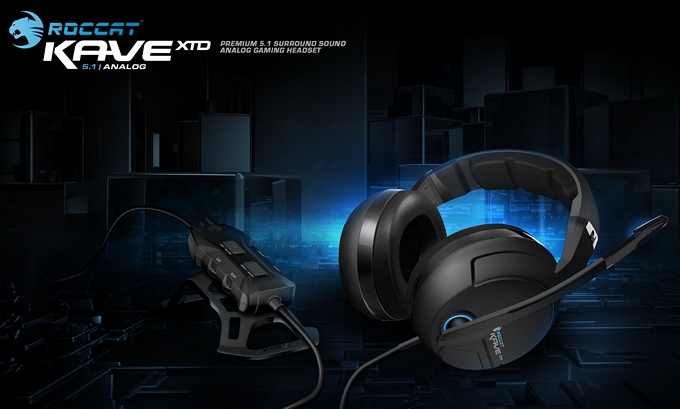
In honor of the significant (in a narrow circle) date - the fifth anniversary of this publication , I decided to share with
I don’t need memoirs, go to the review!
For starters, the reason for replacing the headset in general.
I
First , this is not a very comfortable depreciation on the headset arm, it is implemented in the form of 3 swinging platforms with a soft roller around the perimeter. This design is convenient when the headset is strictly upright on the head, if the bow is moved to the back of the head or to the forehead, then the platforms begin to put pressure on the head with its edges, this is rather painful, but in normal use you do not encounter this (only if you need to open your ears to make hear others).
Second- the headset is closed and it is hot enough if the room temperature is higher than comfortable. This is also a soundproofing fee and is due to the design, so it was clear before buying. The situation is further aggravated by leatherette ear cushions, the skin sweats heavily under them (velor / fabric is more comfortable for me) and they become unusable faster.
Thirdly , the control panel that controlled the system sound settings (volume, mute), in fact because of this I did not use these functions, because then the volume level on the speakers connected in parallel changed.
Otherwise, the headset served (and would continue to serve) faithfully.
Of course, during our life together, the headset was patted:
- the microphone was slightly gnawed by the cat, but this only affected the exterior
- once the wire at the input to the headphone was soldered, because broke inside from bending during use (the signal disappeared in one of the channels). For reliability, the wire was packed in cambric from heat shrinkage, since then everything is fine
- one of the “joints” that allowed folding the headphones broke. I did not use this opportunity, so it makes me neither cold nor hot. Broke, by the way, when putting on the headset, because she has to be “stretched" to comfortably sit on her head. Two-component glue (a la cold welding) reliably solved the problem, although the exterior was damaged (it was possible to grind and paint over, but “the tanks do not wash”). - the headset was also rubbed, the soft touch coating did not come off, but in some places it was wiped to a shine and scratched. I don’t see much sense in it, except for the aesthetics of its dullness.
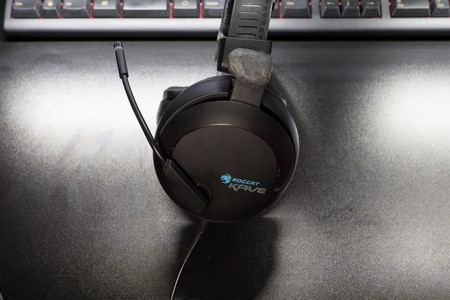
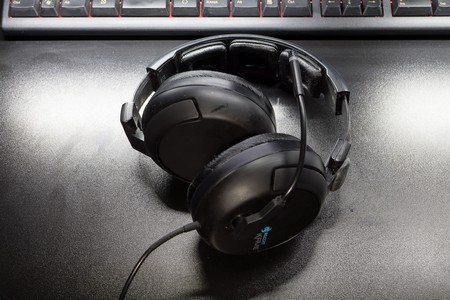
- the ear cushions cracked and peeled off. They also strongly absorb sweat - they need to be taken care of (wiped / washed), otherwise it will be possible to squeeze. Perhaps exchangeable somewhere sold, not looking. As a result, the headset was replaced due to its natural wear and desire for something new, functionally it is quite working. If your hands grow from the right place, then you can replace the ear pads and paint it, such a modding will extend the operational period by another n years.

Replacement Choice
In fact, there was no particular selection process. Fundamentally, we did not consider “digital” headsets connected via usb, this is probably my retrograde, but in terms of 3D sound, I trust my X-Fi Titanium more than the built-in processors of such headsets. Of the analog options was Razer Tiamat 7.1 , but its scattering of small speakers did not impress me (I don’t think that 7.1 can be distinguished from 5.1 in the headphones, but the size of the speakers affects the quality significantly) and the heroine of this review (at the time of the search, was available in one popular store, at the time of publication there were already several options ), nothing worthy came across (I was looking for something in stock in Moscow). As a result, the Roccat Kave XTD 5.1 Analog was ordered.
Actually review
Specifications
- Center / Front / Rear speakers
Frequency range: 20 ~ 20,000Hz Max. rel. signal / noise at 1KHz: 115 ± 3dB Max. input power: 50mW Speaker Diameter: 40mm speaker impedance: 32Ω - Vibration emitters
Frequency range: 20 ~ 100Hz Max. input power: 300mW Diameter: 30mm - Microphone
Frequency response: 10 ~ 10,000Hz Sensitivity at 1KHz: -32 ± -2dB Resistance: 2.2KΩ + 15% Signal Noise: 50dB A type: multidirectional Diameter: 4x1.5mm - General
Connectors: 4 x 3.5mm jack + 1 USB (for power) Length of cable: 3m Headphone Weight: 335g Off site price: 129,99 € Price in Russia: ~ 8000r
Scope of delivery
The headset comes in a large cardboard box with a transparent wall, like the previous version. The packaging is of high quality, in such a way it is not scary to order delivery by mail, and outwardly attractive - it will serve as an excellent “dress” for which one is greeted (photo in a box from the site xsreviews.co.uk , the rest are mine and clickable). Complete with the headset itself is a quick installation guide and a desk stand for the remote control.
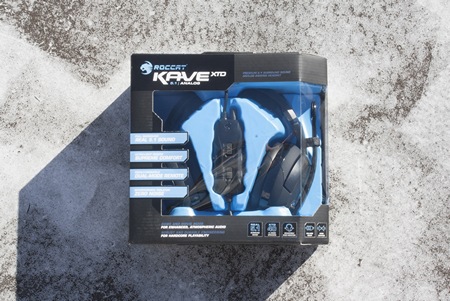
Appearance and comparison
Headphones
The headset looks very similar to its predecessor, the same black matte plastic, soft touch cover cups, emblems and the proud ROCCAT on the headband arch. An LED is installed on the microphone handle, which lights up when the microphone is disconnected from the remote control. Around the arc socket there is a luminous blue ring that lights up when there is power. Both diodes are bright enough to be noticeable, but they don’t need to strain, nothing needs to be glued. Holes are also located behind, as conceived by the creators, perhaps playing some role in the quality of sound, which is doubtful, but they betray the additional highlight of the technological design of the entire product.
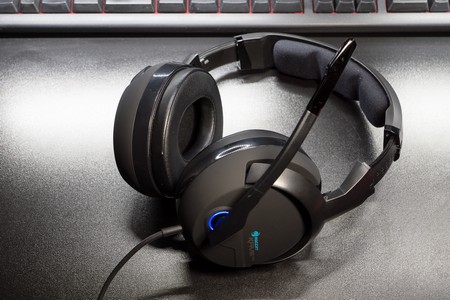

Headphone cups can swing on a handle and turn on a small angle relative to it that provides additional comfort and landing "in place". The handle is moderately wide, adjustable in length, it has marked divisions from 1 to 8, which snap off and fix the set size. Remembering them, you can share the headset with someone else and do not fit it each time by eye :) The bow is equipped with a pillow of some soft foam-like material inside the fabric cover, which, coupled with its width, make the entire structure very comfortable to wear.
The ear pads are removable from soft material a la foam rubber about 15 mm thick, sheathed with a la leather material. I do not understand the quality of leather substitutes, but the material is pleasant to the touch and does not stick to the skin very much. When worn, they completely cover the ears, and due to their size and the size of the holes in them, the ears are inside and the ear pads themselves do not press on them, which provides comfort during prolonged use and better sound insulation.
The headset’s wire is soft, with a diameter of 4 mm (between the headphones and the remote), it does not get confused, the length from the remote to the cup is 120 cm, which allows you to comfortably place the remote on either yourself or on the table.
The design is reliable, when using nothing creaks and does not play, the microphone does not fall by itself.
The appearance is excellent, it will not look out of place either in an adult or a child, the color is neutral, but male. It can be used both in the office and at home.
Let's go through the differences:
- the handle of the removable microphone has become stiff and does not bend, but now it easily rotates in the socket, which makes it easy to move it away from the face when not in use. In the old version, the handle turned tight, but the microphone could be bent in a convenient way so that it would not interfere with drinking from a mug, for example. I can’t evaluate the change positively / negatively, both options are quite fine with me.
- the depreciation system of the headband on the head has changed dramatically for the better, the new headset on my head sits much better and does not cause any inconvenience in any position.
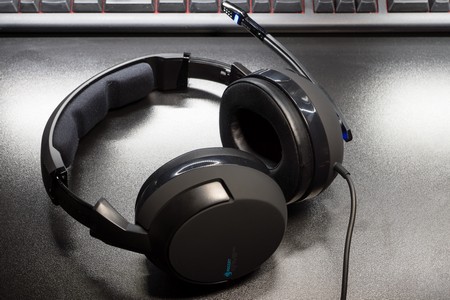
- there are no hinges for folding the headset, which positively affects its strength / reliability. For me, this is a plus, because I have never used this feature on an old headset.
- the range of adjusting the length of the bow became less, on the old divisions there were 10, the difference is about 10 mm on each side. I have a big enough head, but the new ones are quite enough, although to someone, perhaps, the old one will be more convenient in this regard.
Remote control The
second main part of the headset is the remote control for it, and if the headphones themselves have changed only partially, the remote control in the new version is radically different (new on the left). The remote control looks like a mini-walkie-talkie (in fact, the remote control from the honored veteran - Razer Barracuda HP-1
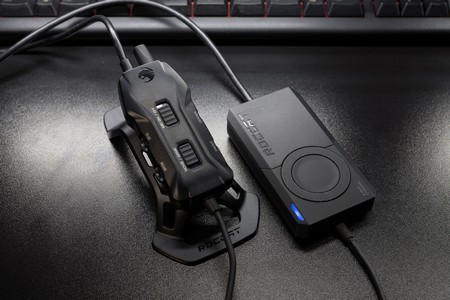
), it is black, oblong, thick enough and equipped with a clip for attaching to clothes.
On the upper edge (based on the location of the manufacturer’s logo), from where the wire goes to the headphones, there is an analog volume control with a switch function. He has a smooth move, quite tight, at the moment the switch trips, a distinct click is felt and heard.
On the side faces there are channel level controls (center, fronts, rear, subwoofer), equipped with a notch for ease of adjustment and digital symbols for clarity. They can completely disable a particular channel.
There are two slide switches in the center, one for turning the microphone on / off, the other for the headset mode (movies / games). They are made of transverse ribs, so it’s convenient to use, you don’t need to apply effort, you can feel it blindly. The clip makes it possible to mount the remote control, both on clothes and on the stand included in the kit, the latter is equipped with anti-slip stickers and allows you to conveniently place the remote control on the table, preventing its spontaneous movements, as well as creating additional convenience when using. Differences:

- The main difference is that the console now only controls the headset. In the old version, the volume control and the mute button worked as multimedia keys, i.e. controlled the system settings of the mixer, this was a significant drawback in my opinion, because I have both speakers and a headset constantly connected, I had to use the volume control in the operating system and the speaker console. In the same games it was inconvenient. In the new version, you can easily choose a comfortable volume level right now and not be afraid that when you turn on the speakers, they will yell because of the volume level set in the system. A plus. Super Plus. Also, due to its analogy, the headset should work fully with devices other than computers (for example, game consoles or home theaters).
- the headphones can now be turned off, the old version always worked if it was stuck in the signal source. This did not interfere, but sometimes it happened that when the speakers were turned off, the computer suddenly reminded itself of itself through headphones, especially if the system volume was set to high
— the operation indicator on the remote control disappeared. For me, this is probably a minus, because Headphones usually hang on the side of the table and I don’t see if the microphone is turned on by the indicator on it, the remote control, in turn, is on the table in front of my eyes, but it is no longer possible to tell whether they are listening to you or not. Paranoid Mode on.
- Level controls can now be easily touched and shifted when moving the remote control or just by accident. I didn’t come across this during use, but nevertheless, in the old version they were completely covered with a lid and it was convenient.
Impressions
The headset sounds good, it is pleasant to listen to music in it, if you are not an audiophile, it’s great to play and it’s convenient to communicate on Skype. There is enough volume with a margin so as not to hear the world around us, but as such, the sound insulation itself is at the standard level for closed-type headphones. There is no distortion at high volume. The multichannel is easily noticeable and gives some advantages in games, vibration emitters greatly improve the impression of low frequencies in music (not everywhere) and of special effects in films / games. Compared to the old version, in terms of sound, I did not notice any special differences.
The microphone also fails, the interlocutors have never complained. He also does not catch stray noise.
It is comfortable and does not get tired of prolonged use, perhaps hotter than we would like, but in overhead headphones there is no where to go. Weight is not felt.
Conclusion
As a result, Roccat turned out to be a worthy heir who not only did not shame the ancestor, but also surpassed him in many ways.
If you want to purchase universal multi-channel headphones, then the Kave XTD 5.1 Analog is an excellent option, nothing remained of the minuses of the old version (from my review), and there were no new ones. However, if those disadvantages are not significant for you, then the old man is also still wow, especially considering its lower cost.
